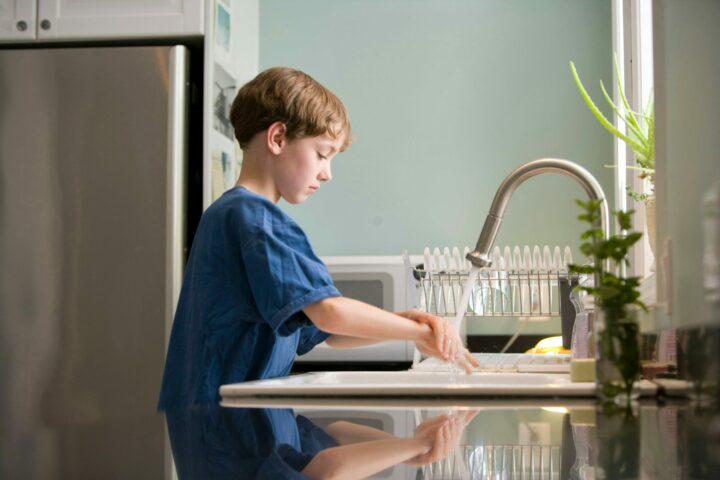The following contribution is from another author.
You might be surprised to learn that one of the best ways to prevent future plumbing problems is to educate your family, especially your kids, on the matter. Kids don’t understand much about plumbing; they think that pipes are indestructible when you know for a fact that’s further from the case. So that’s why you need to have a conversation with them. Basically, you need to teach them right from wrong, or else wrong will happen!
If you think about it, it’s not just about preventing issues either. Every kid will benefit from having some light plumbing skills—even if it’s just unclogging a toilet. With all of that said, where exactly can you even start with this? Well, here’s everything you need to know!
When Should Parents Teach Their Kids About Plumbing
During parenthood, you can expect that your child will cause at least one plumbing accident, which will most likely leave you scrambling to find plumbing companies to hire to fix the issue immediately. Now, needless to say, it’s just not a scenario no one wants to deal with. So it’s best to start young by teaching your kids.
Usually, parents can start introducing basic concepts about plumbing to their children as early as preschool age. You can try when they are toddlers, but they might not grasp much of it. Of course, you’ll have to teach them around potty training time what is and is not allowed in the toilet. So, at preschool age, what can be taught? Well, at this stage, simple explanations about where water comes from, how it travels through pipes, and basic hygiene practices can lay the foundation for future learning.
But of course, the teaching of plumbing (like the dos and don’ts for your home) should still be taught as a kid age; again, a lot of them still think that pipes are indestructible and that all hygiene-related products are okay to flush (such as wet wipes and maxi pads). So, as children grow older, around elementary school age, they can begin to participate in hands-on activities and simple household tasks under supervision. For example, this age bracket is ideal for teaching kids on how to use a plunger or letting them know that food should never go down the drain.
So, it’s best to gradually introduce some plumbing concepts in age-appropriate ways. This will foster a sense of curiosity and responsibility in your children. Plus, it is the best way to set them on the path to becoming knowledgeable and capable individuals when it comes to managing household maintenance tasks—eventually, they’ll need to learn, so why not start now?
Start Them Off with Plumbing Basics 101
For the record, you can make this fun enough for a small child to pay attention to. So, just go ahead and teach your kids about the plumbing system in your home, including how water enters the house, travels through pipes, and exits through drains. If you want (because kids are visual learners), you can use simple diagrams or models to illustrate the different components of the plumbing system, from pipes and valves to faucets and fixtures.
Obviously, you’ll need to make it simple; this doesn’t need to be complex; it’s mostly about teaching them that they can’t clog the drains or put anything down that shouldn’t go down.
It Still Needs to be Fun
Let’s face it—plumbing isn’t always the most riveting topic, even when teaching your child how to use a plunger or why they can’t put toys down the drain. But with a little creativity, you can make it engaging for kids. What might help, if possible, would be to turn plumbing lessons into a hands-on activity by letting them explore basic plumbing tools like plungers, wrenches, and drain snakes. You can even create simple experiments to demonstrate concepts like water pressure and drainage. It’s totally okay if you’re not an expert because the main goal is to just teach the basics.
They Have to be Taught Why
It’s not as simple as saying, “You can’t do this,” because they think they’re not allowed to do something for the sake of not being allowed to do it. That’s obviously not the case for you, but they’re going to see it differently. So, it’s about importing the wisdom that you and all the other big kids and adults know and getting them to understand it. It’s mostly about teaching them to be mindful that no one can do it, that it’s bad for everyone, and that certain things (like a leaky pipe or leaky fixture) are overall just a bad thing that needs to be fixed. So, they need to learn why in order to understand why.
They Need Some Hands-On Learning
It was already mentioned that you could find some images to explain to your kids what is what when it comes to the basics of plumbing. But again, kids, especially preschoolers, get bored fast, and they usually need more “hand-holding” when it comes to teaching them. So, that’s why something more hands-on might help them better understand. If you get hands-on with your plumbing lessons, then this can be more beneficial.
For example by turning everyday tasks into teachable moments (like how to prevent food from getting into the drain). Let your kids help with simple plumbing tasks like turning off the water supply, tightening loose fittings, or cleaning out drain traps. For them, these little chores will be pretty fun. Not only will they learn valuable skills, but they’ll also feel empowered to tackle plumbing challenges on their own (when the time comes, of course).
Celebrate the Little Victories
Something like cleaning the shower drain can be massive for a kid; they do love to contribute, especially getting praise. Honestly, this can be anything like successfully fixing a leaky faucet, unclogging a stubborn drain, or doing the job and handing tools to you, but you need to take time to acknowledge your kids’ accomplishments and celebrate their newfound plumbing skills. If there’s this positive association, they’re going to be more inclined to be mindful of the plumbing in the house. Plus, this is a pretty nice confidence booster too.
















